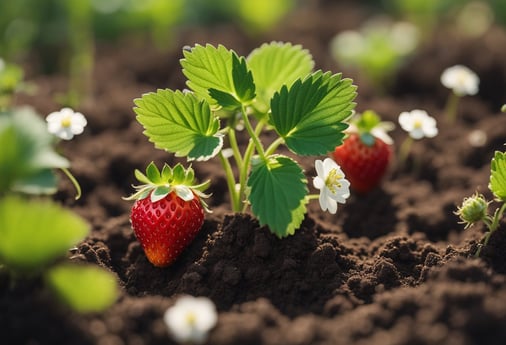Growing Strawberries for a Bountiful Harvest
2/21/20254 min read
Growing strawberries can be a rewarding experience, allowing individuals to enjoy fresh fruit right from their garden. The step-by-step process involves selecting the right variety, preparing the soil, planting, maintaining proper care, and harvesting the fruit. Each stage is essential to ensure a successful crop and abundant yield.
With the right conditions and care, strawberry plants can produce fruit within a few months of planting. They thrive in well-drained soil, ample sunlight, and consistent watering. Understanding how to nurture these plants will lead to delicious strawberries that can be enjoyed fresh or in various recipes.
Gardening enthusiasts at any skill level can successfully cultivate strawberries by following these straightforward steps. By establishing a clear plan, they can enhance their gardening knowledge and experience the satisfaction of growing their own strawberries.
Preparing for Plantation
Preparation is crucial for successful strawberry growth. This involves selecting the best variety, finding the right planting site, preparing the soil, and determining the optimal planting time and techniques.
Selecting the Right Variety
Choosing the right strawberry variety is essential for productivity and sustainability. The main types include:
June-bearing: Produces a single, large crop in late spring or early summer.
Ever-bearing: Offers two to three harvests throughout the growing season.
Day-neutral: Blooms continuously under varying environmental conditions.
Factors to consider include climate adaptability, intended use (fresh eating, freezing, or preserves), and disease resistance. Popular varieties like 'Honeoye' and 'Earliglow' are known for flavor, yield, and hardiness in various regions.
Choosing a Planting Site
The ideal planting site impacts strawberry growth significantly. Strawberries flourish in locations that receive full sun for at least 6-8 hours daily.
Soil drainage is critical; locations with well-drained soil prevent root rot and other diseases. Avoid low-lying areas that may retain water.
Moreover, avoid planting near weeds, as they compete for nutrients and water. A slightly elevated area can be beneficial for drainage and air circulation.
Soil Preparation
Soil preparation is a vital step in ensuring healthy strawberry plants. Begin by conducting a soil test to determine pH levels and nutrient content. Strawberries prefer a pH between 5.5 and 6.5.
Get the best quick soil test here.
Amend soil with organic matter, such as compost or well-rotted manure, to enhance soil structure and fertility.
Tillage should be done 12 inches deep, mixing organic amendments evenly.
Additionally, consider using raised beds, which can improve drainage and facilitate easier harvesting.
Planting Time and Techniques
Timing is essential for planting strawberries. The most suitable times are either early spring or fall, depending on local climate conditions.
Use bare-root plants or transplants. Plant them in rows spaced 18 inches apart and 12 inches apart within rows.
Ensure the crown is at soil level to promote healthy growth. Water thoroughly after planting and mulch with straw or wood chips to retain moisture and suppress weeds.
Consistent care in these steps leads to a fruitful strawberry crop.
Caring for Strawberry Plants
Strawberry plants require specific care to thrive and yield fruit. Attention to watering, mulching, fertilization, pest management, and pruning is vital for healthy growth.
Watering Requirements
Strawberries need consistent moisture, especially during fruit development. Plants require about 1-2 inches of water per week. This can be accomplished through rainfall or supplemental irrigation.
Water the plants deeply to encourage root growth. Drip irrigation is ideal as it minimizes water on the foliage, reducing disease risks. It’s important to avoid overwatering, which can lead to root rot.
Get the best drip irrigation system here.
Using mulch helps retain soil moisture and keeps the roots cool. Evaluating soil moisture levels with a finger test can guide watering schedules.
Mulching and Weed Control
Mulching is essential in caring for strawberries. It suppresses weed growth, retains moisture, and maintains an even soil temperature. Materials such as straw, wood chips, or black plastic can be used.
Weeds compete for nutrients and water, impacting strawberry yield. Regularly inspect for weeds and remove them by hand or with a hoe.
Applying mulch around the plants when they are a few inches tall can significantly reduce weed difficulties. A thick layer of mulch, about 2-4 inches, is recommended.
Fertilization Schedule
Fertilizing strawberry plants supports healthy growth and fruiting. A balanced, slow-release fertilizer is beneficial at planting and should be applied in early spring. Using an organic fertilizer specifically for berry growth is ideal. One of the best ones on the market can be found here.
It’s crucial to follow soil test recommendations to determine nutrient needs. Over-fertilization can lead to leafy plants with poor fruit production.
A nitrogen-rich fertilizer in the spring promotes growth, while an emphasis on potassium and phosphorus during blooming encourages fruit development. Fertilization typically occurs early in the growing season, after the last frost.
Pest and Disease Management
Pest management is critical for strawberry health. Common pests include aphids, spider mites, and strawberry weevils. Using traps or row covers can help manage these pests effectively. Using a pest spray will help keep the pests away.
Regular inspections will help identify problems early. Organic pesticides can be used for significant infestations while adhering to all usage guidelines.
Diseases such as powdery mildew and root rot can affect plants. Ensuring good airflow, proper watering, and crop rotation can help minimize disease risks.
Pruning and Renovation
Pruning is an important step in maintaining strawberry plants. For June-bearing varieties, remove the foliage after harvest. This encourages new growth for the next season.
Renovation involves cutting back the plants to promote healthy growth. This can be done in late summer, ensuring the plants are healthy before entering dormancy.
For everbearing and day-neutral varieties, light pruning can enhance fruit yield. Removing dead or diseased leaves benefits the overall health of the plant. Regular assessments of plant health will guide appropriate pruning efforts.


Harvest
Explore gardening tips, recipes, and pantry ideas.
Disclaimer
© 2025. All rights reserved.
Our blog is reader-supported. When you buy through links on our site, we may earn an affiliate commission
